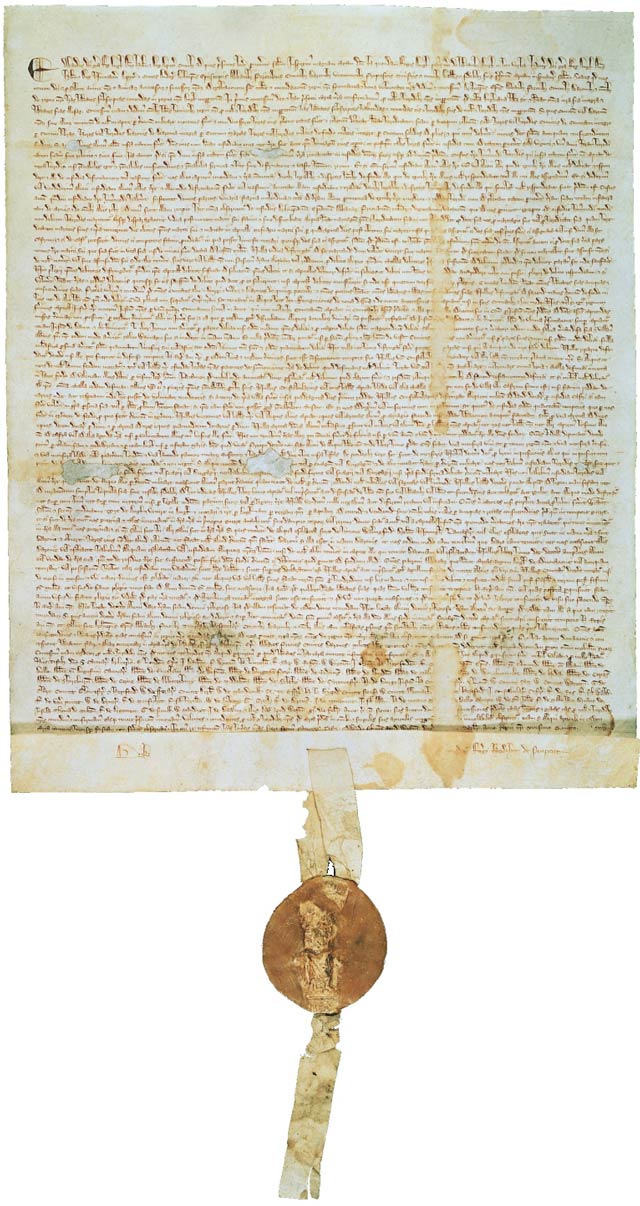What is the Magna Carta?

It is crumbling, water-stained and written in Medieval Latin, but the Magna Carta has managed to remain relevant to the cause of human rights even today, 800 years after it was scrawled on parchment and affirmed with the sticky wax seal of the English king. England's "Great Charter" of 1215 was the first document to challenge the authority of the king, subjecting him to the rule of the law and protecting his people from feudal abuse.
Although most of the charter's ideas were revised or have since been repealed, the Magna Carta's fundamental tenets provided the outline for modern democracies. One of its clauses, still in the English law books, has been credited as the first definition of habeas corpus – the universal right to due process.
Taking a cue from the document more than five centuries later, American revolutionaries incorporated many of the Magna Carta's basic ideas into another important piece of parchment – the U.S. Constitution.
Robin Hood's King John reviled by all
Feudalism was the framework by which all landowning was governed in England during medieval times. It essentially granted the king control of all the land in his kingdom, which was worked by peasants and overseen by feudal barons. Everyone in the hierarchy had financial and social responsibilities to the rank above them, including the barons, who reported directly to the king.
Most of England's kings didn't exercise all of their feudal rights, such as the power to control who their tenants married. That wasn't the case, however, with King John, the ruler fictionalized as the bad guy in "Robin Hood." John's abuses of the feudal system were frequent and angered the barons, who were regularly extorted of their lands and profits.
Fed up, in 1215 the barons rebelled and pressured the king into signing the Magna Carta, a list of 63 clauses drawn up to limit John's power. It was the first time royal authority officially became subject to the law, instead of reigning above it.
Get the world’s most fascinating discoveries delivered straight to your inbox.
Multiple copies of the parchment were inked and sealed in 1215, and read throughout the realm. In 2012, a copy of the Magna Carta created in 1297 was put into a high-tech encasement to protect it. The case was crafted from a single block of aluminum to minimize the number of joints or spots that could cause leaks. And in 2015, researchers with the Magna Carta Project, tasked with studying the history of the document ahead of the 800th anniversary, reported they had found an original copy of the Magna Carta in a scrapbook of sorts in Kent, England. The seventh surviving copy from the 13th century, the newfound Magna Carta brings the tally of the number of surviving versions from that century to 24, the researchers said.
Early colonists sailed over with their rights
Tucked inconspicuously near the middle of the Magna Carta is what historians consider one of the document's most enduring legacies. Habeas corpus, or the right to due process and a trial by jury, is a universal legal concept today, but didn't exist in the law books until the barons noted in the Magna Carta that:
"No free man shall be seized or imprisoned, or stripped of his rights or possessions, or outlawed or exiled … except by the lawful judgment of his equals or by the law of the land."
Though the statement wasn't a standout feature of the Magna Carta when it was first published, it was invoked over the centuries – especially during tumultuous times – to preserve civil liberties. The English Civil War crisis of the 17th-century was one such time, and it was also during this period that many Englishmen set off for the American colonies.
By the mid 18th-century, the New World colonies were populated by a group of first-generation new Americans highly educated in English law, such as Thomas Jefferson and John Adams. At the end of the Revolutionary War, when it was time to draft a constitution for the new United States of America, those men included the best of the English rights they'd been taught, adapted to the circumstances of the monarch-free land.
Still of great significance today, the Fifth Amendment of the U.S. Constitution reads almost identically to that statute, written 575 years earlier.
This article, adapted and updated, was originally part of a LiveScience series about People and Inventions that Changed the World.

